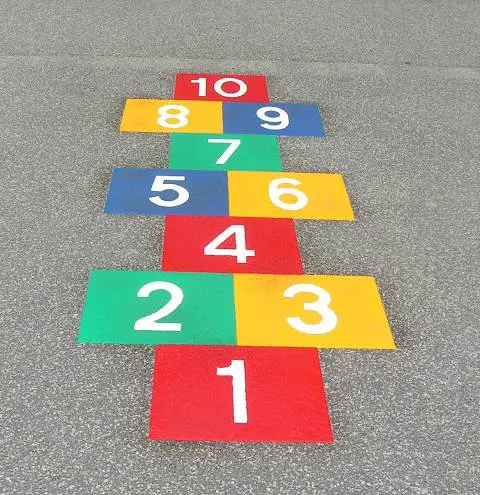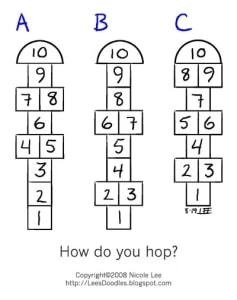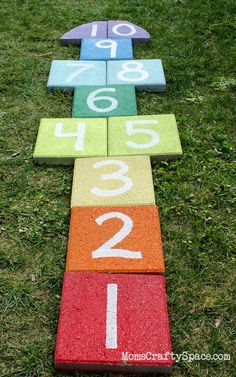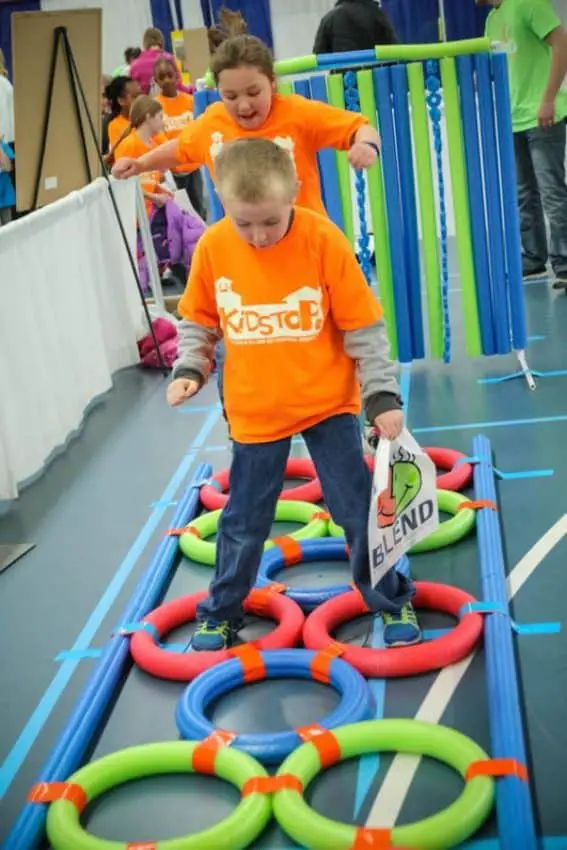Hopscotch is a game everyone of us has played as a child and it’s one of the first outdoor games we play with our own children. It is played across America and around the world. It’s fun and it’s simple. Toss the marker, hop the squares, and reverse. But did you know it actually has rules? And that there are many variations to those rules. The design of the court also has multiple variations you can play. So, let’s get hopping and learn the rules of Hopscotch.
For Nerd’s Like Me, A Brief History of Hopscotch
According to Susan Whiteman of the University at Albany, Hopscotch originated in ancient Britain during the early Roman Empire. Roman soldiers used the courts for military training. Foot soldiers in full armor would run a course, around 100 feet long, to improve their endurance and their foot work. Roman children would draw smaller courts to imitate the soldiers. Early courts would have a free space at the end named London reminiscent of the Great North Road, a 400 mile Roman road from Glasgow to London frequently used by the Roman.
The “Official” Rules:

- The games is played on a court roughly 10 feet long and 3 feet wide. It is made of of sequentially numbered squares.
- The court is laid out on a level surface.
- Each player gets a marker, usually a stone or other small object like a stick, coin or a bean bag.
- The first player tosses his marker on the square marked number 1.
- The marker must land fully in the square, not touching the line. If the marker does touch the line or lands in the wrong square the player forfeits his turn.
- If the toss is successful, the player hops through the court, including the square the marker is on. Side by side squares get both feet, left foot on the left side and right foot on the right side. Single squares must be hopped into on one foot, either the left or the right are okay, but the foot must be alternated for the next single square.
- When the player gets to the end of the court, the player turns around and repeats the course in reverse, picking up his token along the way.
- If the course is completed successfully the player goes again. This time tossing the marker on the space numbered 2. The games continues in this fashion.
- If while hopping through the court in either direction, a player steps on a line, misses a square, or loses his balance and falls down, the players turn ends and no credit is given for that sequence. The player leaves the stone on the square and begins his next turn from the number he left off on.
- The game concludes and a winner is crowned when someone completes all ten numbers on the court successfully.

Variations to The Game
There are quite a few variations to the game. Some of which you have probably played before.
- The most popular variation of the game is that the square with the marker on it may not be used until the player picks the token up on the return trip. So unlike the “official” rules the player skips that space when the course is started.
- Each person completes one number then the next person takes his turn instead of waiting to take turns when someone makes a mistake.
- Each player completes the first sequence as they normally would. For their second turn, each player throws the marker on the square of their choosing and marks it with their initials. That square becomes a safe square for that player only. The players need to avoid marked squares or pay a forfeit to use one. If a player throws on the line or into an already marked spot, that player must complete another sequence before he can try again for a safe spot.
- The player holds the marker between both feet and hops the court without dropping the marker or stepping on a line.
Making a Hopscotch Court
Nowadays most courts are simply drawn on the cement with sidewalk chalk, but you can try these fun ideas to spice it up a bit.

Use paving stones to make a permanent court in you backyard.

For an added challenge, make the court out of water noodles.
Image mildicasdemae.com.br

Foam tiles are available on Amazon for use indoor and out.
Image Lakeshorelearning.com
Fun Things to Try
- Try playing with a timer. Have each player complete one sequence in under 30 seconds or forfeit their turn if they don’t complete it before the time runs out.
- Instead of the player picking up the marker when he gets to it, try kicking it to the next number.
- Switch up the board. Try the alphabet. Use either the whole alphabet or just a section.
- For younger children try mixing up the numbers but still play in sequential order. This way the children have to know the order the numbers go in.
- You can also use the board to help with odds and evens. Asking children to hop on the odd numbers and then even numbers.
- Challenge children to create their own court design.
Benefits of to Children
Hopscotch is a great learning tool for young children. It helps them with eye-hand and eye-foot coordination as well as balance and agility. It also helps them manage body rhythm. Children can say the numbers as they hop to reinforce number sequence and counting skills. On top of that it improves social skills and if you encourage children to make up their own rules it will improve their creativity.
Fun Facts
- In France the game is called Escargot, which means snail. The court is also shaped in a spiral like a snails shell instead of a rectangle.
- According to the Guinness Book Of World Records the longest hopscotch game measures 6,131 m (20,114 ft 9.47 in) and was created by Brand Teenmix of Belle International (China) in Guangzhou, Guangdong, China, on 5 May 2016. The course consisted 1,518 standard hopscotch games and over 300 participants took part in the two days event. May 5, 2016
- The marker is sometimes called a Lucky, a Peever or a Potsie.
